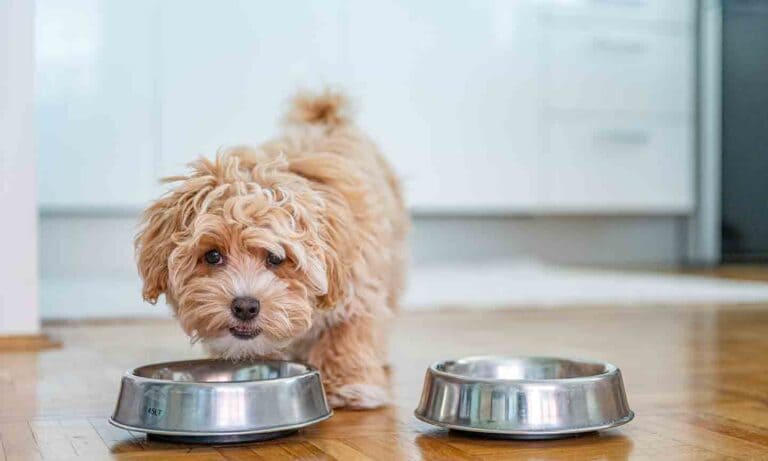Whether it’s a soothing spoonful in tea or a sweet drizzle over your morning toast, honey is a natural sweetener used by millions of people daily. As you savor its sugary goodness, you might wonder, “Can dogs have honey, too?”
Honey is non-toxic to dogs and safe in small quantities. However, because of its high sugar levels, overindulgence could contribute to health complications such as dental issues, obesity and diabetes.
We spoke to a vet expert to get the scoop (or perhaps spoonful) on honey and hounds, discussing its benefits, potential risks and guidelines for safely offering this golden nectar to your pup.
Can Dogs Have Honey?
Click to jump to each section.
What Kind of Honey Is Safe for Dogs?
When considering giving honey to your dog, it’s important to be aware of the different types and their unique benefits and risks.
Let’s look at the two most common types of honey:
Raw Honey
This type of honey is unpasteurized, making the journey from hive to jar in its most natural state. Raw honey is typically considered the best option for most dogs, as it retains all the beneficial nutrients and medicinal properties.
However, raw honey should not be given to puppies or to dogs with a compromised immune system, as it can contain bacteria that their developing or weakened immune system may be unable to handle.
Pasteurized Honey
The pasteurization process—which exposes the honey to high temperatures—improves the honey’s appearance, increases its shelf life, kills yeast cells that can affect the taste, and eliminates any potentially harmful bacteria.
However, this heat treatment is believed to substantially diminish or entirely eradicate the honey’s beneficial compounds. As a result, this option offers your dog little more than sugar.
Pasteurized honey is still OK to use in small amounts, such as in homemade dog treat recipes for a little added sweetness.
How Much Honey Can I Give My Dog?
As a general rule of thumb, dog treats and human foods should make up no more than 10 percent of your dog’s daily calories. The other 90 percent should come from well-balanced dog food.
A teaspoon of honey contains about 20 calories and 6 grams of sugar. The amount of honey that’s safe for your dog will vary based on their size.
Here are general recommendations for healthy dogs:
- Very small dogs (2-20 pounds): 1/4 teaspoon or less daily
- Small dogs (21-30 pounds): 1/2 teaspoon or less daily
- Medium dogs (31-50 pounds): 1 teaspoon or less daily
- Large dogs (51-90 pounds): 1 1/2 teaspoons or less daily
- Very large dogs (91+ pounds): 2 teaspoons or less daily
5 Ways To Feed Your Dog Honey

If you’ve consulted with your veterinarian and decided that honey would be a beneficial and enjoyable addition to your dog’s diet, you might be wondering about the best ways to serve it.
Here are some creative and simple ways to give your dog a taste of this sweet treat:
1Give Them a Direct Spoonful
Want to keep it simple? Measure the appropriate amount of raw honey in a spoon and let your dog lick it off. This method is especially useful for dogs experiencing a mild cough.
2Drizzle It Over Their Food
Add a little culinary excitement to your dog’s regular meal by drizzling a small amount of raw honey over their dog food. This is an excellent way to provide the nutritional benefits of honey while enhancing the flavor of their regular diet.
3Make Frozen Honey Cubes
For a refreshing summer treat, make frozen honey ice cubes, which can be a cooling, hydrating and tasty treat.
Simply mix 1 tablespoon of honey with 1 cup of water and freeze the mixture in an ice cube tray.
To minimize the risk of choking and dental damage, avoid giving your dog the honey ice cubes whole. Instead, crush them up into smaller pieces to serve.
4Make Homemade Dog Treats With Honey
Show love for your pup by whipping up some homemade dog treats that incorporate honey as one of the ingredients.
For example, these protein-packed PB&J No-Bake Treats are a great option. Plus, they’re appropriate for dogs and humans alike, so you can enjoy them along with your furry, four-legged friend!
5Offer Store-Bought Dog Treats With Honey
For convenience, consider purchasing store-bought dog treats that contain honey as an ingredient. Some buzz-worthy options to try include:
Health Benefits of Honey for Dogs
While honey should not be considered a dietary staple for dogs, it does offer some intriguing health benefits when given in appropriate amounts. Here are some of the positive effects your dog could experience:
Nutritional Boost
Raw, unpasteurized honey is rich in antioxidants, B vitamins, vitamin C and several minerals, including calcium, magnesium, potassium, manganese and zinc.
When incorporated into a balanced diet, these nutrients can support a strong immune system and contribute to your dog’s overall well-being.
Anti-Inflammatory Effects
Raw honey possesses anti-inflammatory properties that can help soothe internal and external inflammation. This may contribute to your dog’s overall wellness and potentially aid in soothing minor injuries or joint pain.
Cough Support
The antimicrobial and anti-inflammatory effects of honey make it a good home remedy for mild cases of kennel cough. The honey may help soothe your dog’s sore throat, kill harmful bacteria and reduce coughing.
For acute cough support, you can give your pooch a little more honey than usual—1 teaspoon to 1 tablespoon daily, depending on their size. Mix the honey with a little warm water and encourage them to drink the mixture.
Note: This remedy should only be used after checking in with your veterinarian.
Wound Care
Apart from adding honey to your dog’s diet, a specific type of honey called Manuka honey could serve as a valuable addition to your wound-care arsenal. This unique variety is renowned for its heightened concentrations of antibacterial properties and specialized compounds, making it exceptionally well-suited for healing cuts, scratches, bites, hot spots, pressure sores and burns. (It’s also antifungal!)
For minor wounds, gently clean the area first. Then, apply a small amount of honey over the wound. Cover the wound with a light bandage to prevent your dog from licking the honey off.
Note: This home remedy should only be used for minor wounds. If your dog is seriously injured, immediately take them to your veterinarian or a pet emergency clinic.
Risks of Honey for Dogs
While honey has a variety of potential health benefits for dogs, it’s important to be aware of the associated risks. Here are some things to consider:
Risk of Dental Issues
Honey is primarily composed of natural sugar. Over time, if a dog eats too much sugar it can negatively affect their teeth, causing tooth decay.
If your dog already has dental issues, do not feed them honey.
Risk of Diabetes
Due to honey’s high sugar content, excessive consumption could impact your dog’s blood sugar levels, potentially contributing to the onset of diabetes.
Diabetic dogs should not consume honey of any kind.
Risk of Botulism
Raw honey can contain botulism spores—a type of bacteria that can cause a rare but serious illness called botulism, which attacks your dog’s nervous system.
Botulism spores are generally harmless to adult dogs who have a robust immune system but could pose a risk to puppies and immunocompromised dogs.
Caloric Density
Honey is calorically dense and can contribute to weight gain if given in large amounts.
Pet parents should not feed honey of any kind to sedentary or obese dogs.
Allergic Reaction
Though rare, some dogs may have an allergic reaction to the pollen or other natural substances found in honey.
Signs of an allergic reaction can include itching, swelling, difficulty breathing or gastrointestinal issues.
Always start with a small amount and closely monitor your dog for any adverse reactions.
If you notice symptoms of an allergic reaction, consult your veterinarian immediately.
FAQs About Honey and Dogs
Q:
How much honey can I give my dog for a cough?
Q:
Is there xylitol in honey?
Q:
Does honey help a dog’s upset stomach?
Q:
Can honey help my dog’s seasonal allergies?
Q:
What happens if I give my dog too much honey?
More human foods dogs can eat:
Share:














